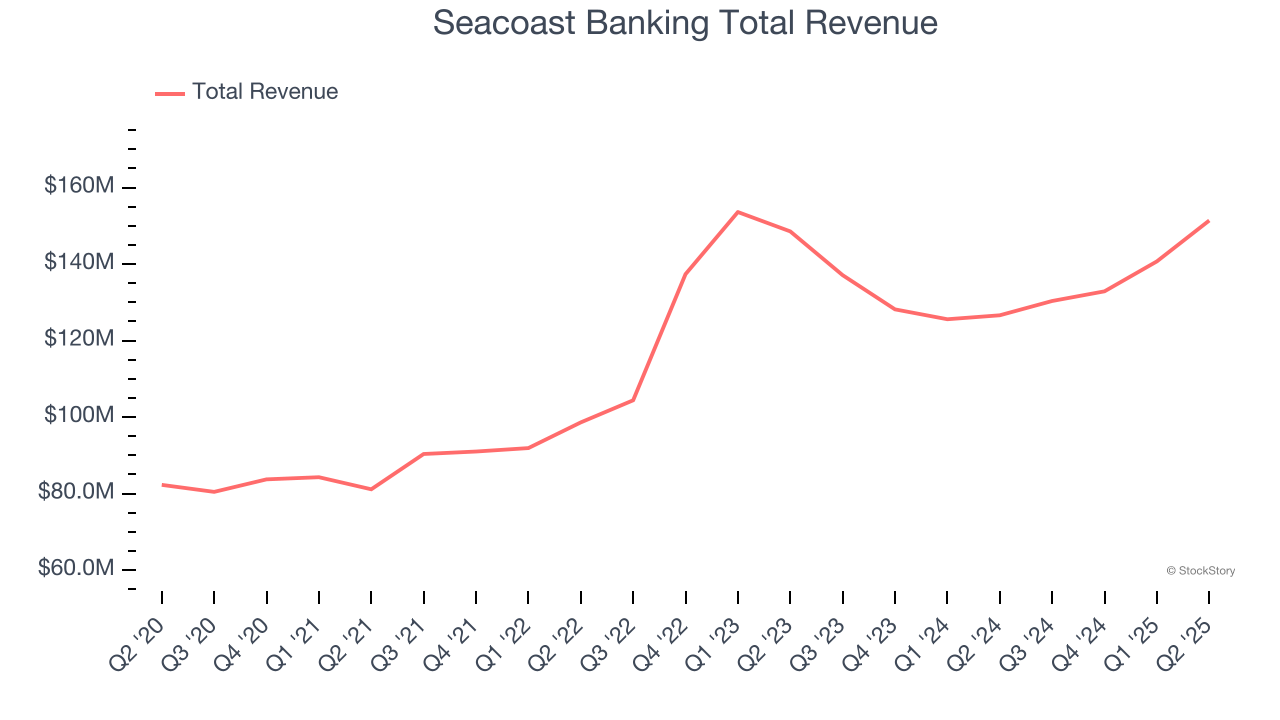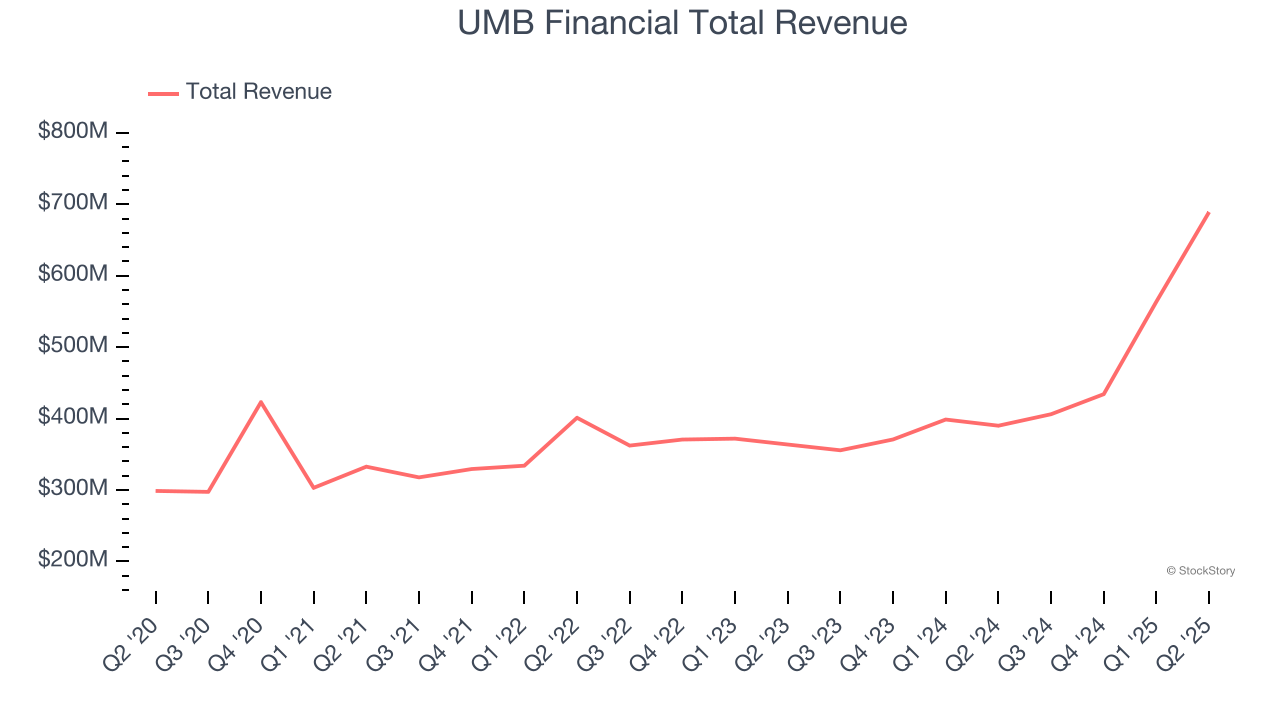
As the Q2 earnings season wraps, let’s dig into this quarter’s best and worst performers in the regional banks industry, including Seacoast Banking (NASDAQ: SBCF) and its peers.
Regional banks, financial institutions operating within specific geographic areas, serve as intermediaries between local depositors and borrowers. They benefit from rising interest rates that improve net interest margins (the difference between loan yields and deposit costs), digital transformation reducing operational expenses, and local economic growth driving loan demand. However, these banks face headwinds from fintech competition, deposit outflows to higher-yielding alternatives, credit deterioration (increasing loan defaults) during economic slowdowns, and regulatory compliance costs. Recent concerns about regional bank stability following high-profile failures and significant commercial real estate exposure present additional challenges.
The 98 regional banks stocks we track reported a satisfactory Q2. As a group, revenues were in line with analysts’ consensus estimates.
In light of this news, share prices of the companies have held steady. On average, they are relatively unchanged since the latest earnings results.
Seacoast Banking (NASDAQ: SBCF)
Founded during the Florida land boom of 1926 and surviving the Great Depression, Seacoast Banking Corporation of Florida (NASDAQ: SBCF) is a financial holding company that provides commercial and retail banking, wealth management, and mortgage services throughout Florida.
Seacoast Banking reported revenues of $151.4 million, up 19.6% year on year. This print exceeded analysts’ expectations by 5%. Overall, it was a stunning quarter for the company with EPS in line with analysts’ estimates and a solid beat of analysts’ net interest income estimates.
Charles M. Shaffer, Seacoast's Chairman and CEO, said, “Our performance in the second quarter showcases the strength and momentum of our franchise. The expansion in net interest margin is a direct result of the disciplined execution and strategic focus of the Seacoast team. We’re seeing the benefits of consistent, high-quality loan growth and well-managed deposit costs, which are fueling strong net interest income growth. Our fee-based revenue businesses continue to expand and expenses are well controlled.”

Interestingly, the stock is up 1.4% since reporting and currently trades at $29.25.
Is now the time to buy Seacoast Banking? Access our full analysis of the earnings results here, it’s free.
Best Q2: UMB Financial (NASDAQ: UMBF)
With roots dating back to 1913 and a name derived from "United Missouri Bank," UMB Financial (NASDAQ: UMBF) is a financial holding company that provides banking, asset management, and fund services to commercial, institutional, and individual customers.
UMB Financial reported revenues of $689.2 million, up 76.7% year on year, outperforming analysts’ expectations by 8.6%. The business had a stunning quarter with EPS in line with analysts’ estimates and an impressive beat of analysts’ tangible book value per share estimates.

The market seems happy with the results as the stock is up 6.3% since reporting. It currently trades at $116.68.
Is now the time to buy UMB Financial? Access our full analysis of the earnings results here, it’s free.
Weakest Q2: Coastal Financial (NASDAQ: CCB)
Pioneering the intersection of traditional banking and financial technology in the Pacific Northwest, Coastal Financial (NASDAQ: CCB) operates as a bank holding company that provides traditional banking services and Banking-as-a-Service (BaaS) solutions to consumers and businesses.
Coastal Financial reported revenues of $119.4 million, down 11.7% year on year, falling short of analysts’ expectations by 21.5%. It was a disappointing quarter as it posted a significant miss of analysts’ net interest income estimates and a significant miss of analysts’ EPS estimates.
Interestingly, the stock is up 6.9% since the results and currently trades at $108.45.
Read our full analysis of Coastal Financial’s results here.
Westamerica Bancorporation (NASDAQ: WABC)
Founded in 1884 and serving communities from Mendocino County in the north to Kern County in the south, Westamerica Bancorporation (NASDAQ: WABC) provides banking services to individuals and small businesses throughout Northern and Central California.
Westamerica Bancorporation reported revenues of $64.59 million, down 13% year on year. This print topped analysts’ expectations by 0.7%. Taking a step back, it was a mixed quarter as it also produced a narrow beat of analysts’ net interest income estimates but a significant miss of analysts’ EPS estimates.
The stock is down 1.2% since reporting and currently trades at $50.17.
Read our full, actionable report on Westamerica Bancorporation here, it’s free.
First Busey (NASDAQ: BUSE)
Tracing its roots back to 1868 during America's post-Civil War reconstruction era, First Busey (NASDAQ: BUSE) is a bank holding company that provides commercial and retail banking, wealth management, and payment technology solutions across Illinois, Missouri, Florida, and Indiana.
First Busey reported revenues of $198 million, up 70.4% year on year. This result beat analysts’ expectations by 2.4%. Zooming out, it was a satisfactory quarter as it also logged a solid beat of analysts’ tangible book value per share estimates but EPS in line with analysts’ estimates.
The stock is down 2.2% since reporting and currently trades at $23.66.
Read our full, actionable report on First Busey here, it’s free.
Market Update
As a result of the Fed’s rate hikes in 2022 and 2023, inflation has come down from frothy levels post-pandemic. The general rise in the price of goods and services is trending towards the Fed’s 2% goal as of late, which is good news. The higher rates that fought inflation also didn't slow economic activity enough to catalyze a recession. So far, soft landing. This, combined with recent rate cuts (half a percent in September 2024 and a quarter percent in November 2024) have led to strong stock market performance in 2024. The icing on the cake for 2024 returns was Donald Trump’s victory in the U.S. Presidential Election in early November, sending major indices to all-time highs in the week following the election. Still, debates around the health of the economy and the impact of potential tariffs and corporate tax cuts remain, leaving much uncertainty around 2025.
Want to invest in winners with rock-solid fundamentals? Check out our Strong Momentum Stocks and add them to your watchlist. These companies are poised for growth regardless of the political or macroeconomic climate.
StockStory is growing and hiring equity analyst and marketing roles. Are you a 0 to 1 builder passionate about the markets and AI? See the open roles here.





